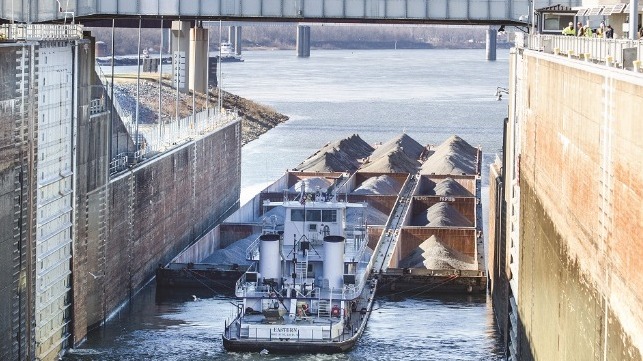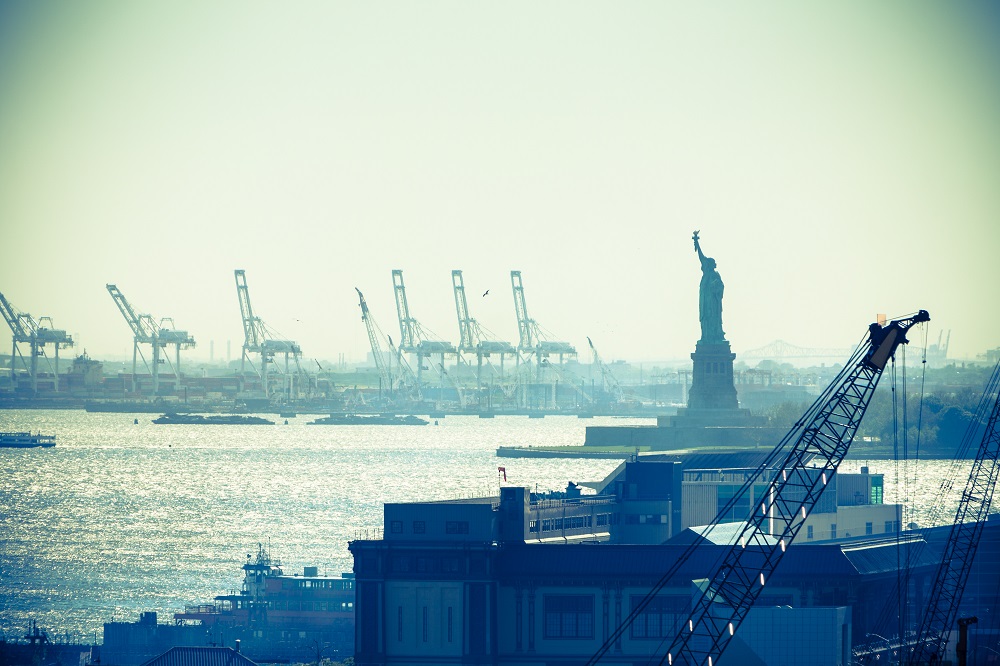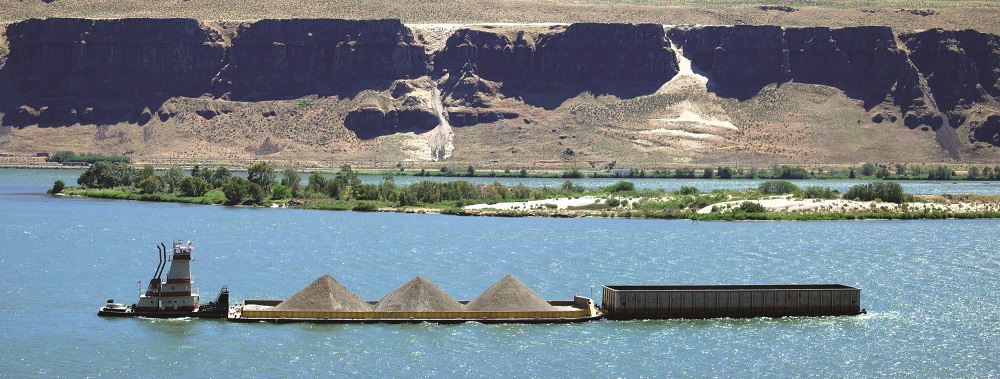Update: Can the U.S. Fix Its Failing Infrastructure?
Overall infrastructure spending has fallen, according to the Congressional Budget Office, but the need is greater than ever

(Article originally published in July/Aug 2017 edition.)
In the July-August 2017 edition, Tony Munoz, Publisher & Editor-in-Chief of The Maritime Executive, wrote a critical piece on U.S. infrastructure or failing locks, dams, highways and bridges in “Can the U.S. Fix Its Failing Infrastructure?”
The editorial team believes this important and critical article should be reprinted to remind us of the importance of waterways and dams and port infrastructure on the health of the U.S. economy.
-----
It’s no secret that America’s infrastructure is crumbling. Just look around you. Everywhere there are potholed streets, congested highways, trains going off the tracks, bridges collapsing, dams and locks failing, and levees leaking. The problem is especially acute on the nation’s inland waterways, whose system of locks and dams was built largely in the 1930s, and where barge traffic can be delayed for days or even weeks because of a failed lock.
According to a recent report from the American Society of Civil Engineers (ASCE), more than $3.6 trillion will be needed by 2020 to address the nation’s aging infrastructure. In the next ten years, investment shortfalls will impact ports by $168 billion, rail by $116 billion, airports by $26 billion and roadways by $3.4 trillion.
And the U.S. is not alone. It’s a global issue. According to another report, this one from Oxford Economics and the G20’s Global Infrastructure Hub, the world will need about $100 trillion by 2040 just to keep the wheels rolling, the trains running, the airplanes flying and the ships sailing. Not surprisingly, the U.S. faces the biggest funding gap of all with about one-third of needed improvements expected to go unmet. Meanwhile, countries like Germany and France and our neighbor to the north are moving forward and expected to fully fund their own pressing infrastructure needs.

Why is this important? Because the country’s economic security depends on it – not to mention its military security – and we are in danger of falling farther behind if something is not done soon. The maritime sector alone accounts for more than $4.6 trillion in economic activity annually – 26 percent of the U.S. economy. Yet there are key choke points in the inland waterways system and only a handful of U.S. ports that can accommodate the growing fleet of mega-cargo ships. These shortcomings need to be fixed.
The New Administration
Enter the Trump Administration and its promise to “Make America Great Again.” The Administration has pledged a $1 trillion investment in much-needed infrastructure improvements, which is a good start, but not nearly enough. But when will it happen?
Seven months in and the Trump team is still trying desperately to get its own house in order. Having alienated allies on both the left and right, at home and abroad, and having failed in its effort to pass new health care legislation, it seems incapable these days of even initiating – let alone enacting – any of its campaign promises.
Secretary of Transportation Elaine Chao is a notable exception and a shining star. Chao is the most experienced and qualified person on the Trump team when it comes to domestic affairs. She is a savvy administrator who knows her way around Washington and can be counted on to get things done. And she clearly understands the importance of maritime to the U.S. economy, her father being a renowned shipowner and she herself having served as Deputy Administrator of the Maritime Administration and Chairwoman of the Federal Maritime Commission, among many previous high-level appointments.
“The maritime industry is an integral component of the nation’s broader transportation network,” she explains in an exclusive interview, “and plays an important role in an efficient intermodal system. The nation’s economic prosperity and national defense rely on a fully-integrated intermodal transportation system with each mode linked to and complementing the others. Maritime has historically played a major role in this country’s economic growth and military power, and its importance remains.”
Commenting on Trump’s $1 trillion infrastructure pledge, Chao notes that just $200 billion in federal funds will be made available over the next ten years and the remaining $800 billion must come from private partners and local governments. And that’s not just for maritime. That’s for everything, the whole shebang – roads, rails, bridges, mass transit, dams and locks. And the bulk of it will go to mass transit.
But she says there are other funding options available: “Public-private partnerships have already been successfully utilized in some states and are widely used globally. Some states do not allow private sector investment in public infrastructure, and this barrier needs to be removed. Public private partnerships, or ‘P3s,’ are very popular overseas in Britain, Australia and many other countries. But many investors say the chief impediments to private infrastructure investments are the regulatory and permitting processes that can delay projects for decades.”
Chao adds that the Administration is exploring ways to streamline these processes, use funds more effectively and defer risk to private investors: “With the Army Corps and other federal partners, we are also exploring ways to target funding and investment more effectively for construction, operation and maintenance of infrastructure.”
But challenges remain. DOT’s proposed FY 2018 budget is being cut by nearly 13 percent along with a 26 percent cut in the Maritime Administration’s budget, a clear indication of how the new Administration views maritime and a blow to any hopes of federal maritime leadership. The budget cuts signal that the maritime sector will get little support from Washington in maintaining a healthy U.S.-flag deepwater fleet and an adequate supply of licensed merchant mariners, both of which are essential to economic and national security and both of which survive largely on cargo preference, military cargoes and foreign aid programs.
As Jim Henry, President of the government-watchdog Transportation Institute, representing U.S.-flag shipowners and operators, puts it: “The U.S. maritime industry is a driver of American economic growth and a contributor to national and homeland security. Transportation Institute advocates for the prioritization of investment in maritime programs and infrastructure so that the industry can continue to provide secure cargo movement to the nation. The fate of the maritime industry is highly dependent on strong federal policy.”
Jones Act in the Crosshairs?
As the Trump Administration continues to unravel laws and regulations, the Jones Act might very well be in the crosshairs once again. Cabotage laws for U.S. maritime are considered essential for both economic security and homeland defense. Yet despite its obvious merits and the fact that it has served the country well for nearly 100 years, the Jones Act remains a lightning rod for opponents – among them Senator John McCain (R-AZ), the domestic oil and gas industry, Puerto Rico and the states of Alaska and Hawaii.
“Critics will always nitpick elements of the Jones Act,” notes Tom Crowley, Chairman, President & CEO of Crowley Maritime Corporation, “and some will even call for its reform. But that cannot be allowed to happen. It is absolutely essential to our nation’s economic and national security. Without it, there would be no U.S. shipyards and no U.S. merchant marine.”
Fortunately, Chao agrees: “The Jones Act addresses both national defense and economic issues. The U.S. Merchant Marine and the Maritime Administration help ensure that our nation has the capacity to deploy combat equipment and supplies anywhere in the world on short notice, to surge and sustain our armed forces while they are in theater and redeploy safely when their mission is done. So the Jones Act helps achieve many strategic national objectives.”
Echoing Crowley’s remarks, she adds that “The ‘build requirement’ for the Jones Act is responsible for roughly 400,000 direct, indirect and induced jobs nationally, supporting the U.S. shipbuilding industry, which contributes over $36 billion to the gross domestic product annually and $24 billion in annual income for workers. In addition to their proven economic value, Jones Act vessels play an essential role in homeland security and national defense.”
Yet the U.S. deepwater fleet has steadily shrunk. “Since 2012, the number of U.S. vessels trading internationally has declined from 106 to 81,” notes Jim Caponiti, President of the American Maritime Congress. “While solutions could involve expanding the breadth of cargo preference authority to a wider range of conventional government cargoes, the industry also views bilateral trade agreements, especially related to energy exports, as potential cargo opportunities to leverage in the future.”
That means potentially expanding the U.S.-flag fleet to cover such things as U.S. crude oil and LNG exports, and there is already a bill in Congress that would do just that. H.R. 6455, the “Energizing American Maritime Act,” would require that up to 30 percent of U.S. LNG and crude oil exports travel on U.S.-flagged vessels.
The bill was introduced last December by Representative John Garamendi (D-CA) and is cosponsored by Representatives John Duncan (R-TN) and Duncan Hunter (R-CA). It would create thousands of maritime jobs and revitalize the nation’s shipyards by mandating the construction of U.S.-flag crude carriers and LNG carriers. While the U.S. has several dozen medium-size petroleum products carriers, it currently has zero large crude oil carriers and zero LNG carriers.
Garamendi’s bill is a form of “cargo preference,” giving U.S.-flag vessels preference over those of other nations, and it is a proven way of boosting the industry. One of the best-known cargo preference laws is PL-480, the “Food for Peace” Act, which mandates the use of U.S.-flag vessels in transporting food aid to poor nations abroad. Currently, the Act requires that 50 percent of all such cargoes be carried in U.S. bottoms, but Trump has indicated he will raise that number to 100 percent.
“PL-480 food aid exports represent the ‘Buy American, Hire American’ canon that drives the Trump Administration,” says Paul Doell, President of American Maritime Officers. “Farm products grown, processed, packaged and transported in the U.S. to deep-sea ports for delivery to poor and developing countries in U.S.-flagged merchant ships serve humanitarian interests, promote American ideals, yield diplomatic dividends and enhance U.S. national security, all while sustaining thousands of jobs in key economic sectors.”
The Jones Act and cargo preference go a long way toward ensuring a viable U.S.-flag bluewater fleet and a sufficient supply of trained and skilled merchant mariners. But they are not enough. More is needed, both from an economic and national security standpoint.
“Ignoring our maritime resources and allowing our merchant marine to wither on the vine is not consistent with maintaining national security,” states Don Marcus, President of the International Organization of Masters, Mates & Pilots, who estimates the current skilled mariner shortage at approximately 2,000 seafarers. “At the present time, skilled mariners – the most critical of whom take ten to fifteen years to fully train – are leaving the industry due to diminishing future prospects.”
Ports and Inland Waterways
U.S. seaports support 23 million jobs and provide $321 billion in taxes to federal, state and local governments. But today’s mega-cargo ships are impacting ports and landside operations, which are getting more congested each year. Only a few U.S. ports can accommodate these ships, and others are scrambling to catch up.
The ASCE report cited earlier gives America’s ports a C+ rating, and the American Association of Port Authorities (AAPA) states that more than $154 billion is needed over the next five years for dredging and maintenance along with new and upgraded cargo and passenger facilities. Those new investments could in turn generate more tonnage on “America’s Marine Highway,” its inland waterways, which would ease highway congestion on busy corridors like I-95 along the U.S. East Coast.

The Harbor Maintenance Trust Fund (HMTF) was created in 1986 to help fund the port and harbor dredging activities of the U.S. Corps of Engineers. It has a current balance of $9 billion and collects about $1.7 billion each year. Unfortunately, these monies often remain idle or are used for other purposes like deficit reduction.
“Funding is obviously needed to improve the infrastructure, but securing sufficient support requires that we speak with one voice,” says Kurt Nagle, President of AAPA. “This is a nonpartisan issue that affects all modes of transportation and essentially every type of business. The U.S. President is talking about major investments and the time is now to make those investments.”
Chao agrees but says securing financing may not be the biggest hurdle. “Streamlining regulations to make these big projects more attractive to private investors will be the biggest challenge,” she says. “Targeting funding and investment more effectively will also go a long way in helping to incentivize projects of regional and national significance.” She adds that economists say investments in ports provide the best return of any transportation project – nearly $7 for every dollar invested. So what are we waiting for?
Representatives Peter DeFazio (D-OR) and Mike Kelly (R-PA) aren’t waiting, having introduced a bill in April called “Investing in America: Unlocking the Harbor Maintenance Trust Fund.” The bill seeks to provide $18 billion over the next decade for much-needed infrastructure investment – a much-needed step in the right direction.
A similar funding problem exists with the inland waterways, whose locks and dams are given a D- rating by the ASCE report. The U.S. is blessed with a natural abundance of inland waterways, a network of interconnected rivers transporting more than 700 million tons of cargo annually, representing about 14 percent of all domestic freight, and supporting more than 300,000 jobs. The system also includes the Intracoastal Waterway, which supports ports along the East Coast, Texas and the Pacific Northwest.
The U.S. Army Corps of Engineers is responsible for maintaining the 12,000 miles of inland waterways, which are funded on a 50-50 basis by a fuel tax deposited in the Inland Waterways Trust Fund and by the federal government. The Army Corps estimates that $4.9 billion will be needed to keep the system operational over the next twenty years.
Many of the locks and dams in the waterways are beyond fifty years of age and in dire need of replacement. More than half the vessels working on the waterways are experiencing big delays, which directly affect the economies of thirty-eight states. Barge tows are being reduced in order to pass through many of the locks, causing long delays through key parts of the system.
And of course we all know the saga of the Olmsted Locks and Dam project on the Ohio River, the largest and most expensive (and overbudget) civil works project in the nation’s history, extending over three decades and costing north of $3 billion, which is finally expected to open next year.
“Waterways infrastructure must be included in the Administration’s initiatives,” explains Mike Toohey, President and CEO of Waterways Council, “but proposals for its funding must be fair, equitable and continue to facilitate capacity and competition for American farmers, coal miners, steel producers and manufacturers, who rely on the waterways to ship their goods for use domestically and to the world market.”
Toohey says the barge and towboat owners he represents want “full use” spending of Inland Waterways Trust Fund and not the “bare use” spending included in the President’s FY 2018 budget request. The money is there, so why not use it?
The Big Picture
Fixing the nation’s failing maritime infrastructure is a big part of an even bigger picture. And that picture depicts a sorely needed national maritime strategy, an all-encompassing vision that unites the nation’s energies in pursuit of a clearly defined goal. There have been attempts at this over the years, and even as recently as a few years ago MARAD was working on such a plan. But nothing came of it, and while other nations forge ahead with their clearly articulated maritime policies, the U.S. flounders.
To make it happen, the industry must “speak with one voice,” as the AAPA’s Nagle puts it. And the policy must include both economic and national security imperatives, twin principles that have been embedded in the mission of the U.S. Merchant Marine from the beginning. Fixing our infrastructure satisfies the economic imperative, ensuring that America will continue to lead the world in economic output and prosperity. And it goes a long way toward meeting the national security imperative as well.
MARAD’s national security mission was most recently affirmed in the Maritime Security Act of 1996, which also established the Maritime Security Program (MSP) and the Voluntary Intermodal Sealift Agreement (VISA). Today, MARAD owns and operates forty-six Ready Reserve Force ships, located around the nation. The RRF vessels are maintained by commercial ship managers and expected to be fully operational in five to ten days of the notice to activate.
“MSP provides a secure, time-tested U.S. citizen-operated supply network at a fraction of the cost that it would take for the military to accomplish by itself,” says the IOMMP’s Marcus. “Independent of the commercial sphere, MSP must be recognized as an important part of the larger federal maritime structure.”
Adds the AMO’s Doell, in typically blunt fashion: “The plain truth is that the U.S. cannot go to war without its commercial merchant fleet or its seagoing professionals.”
Perhaps it’s too much to expect of Secretary Chao and the new Administration to do all of this at once. But Chao is optimistic. She says President Trump will be good for maritime: “He and the entire Administration are committed to improving, rebuilding and revitalizing all of our nation’s infrastructure – including maritime.” – MarEx
Tony Munoz is Publisher & Editor-in-Chief of The Maritime Executive.
The opinions expressed herein are the author's and not necessarily those of The Maritime Executive.
